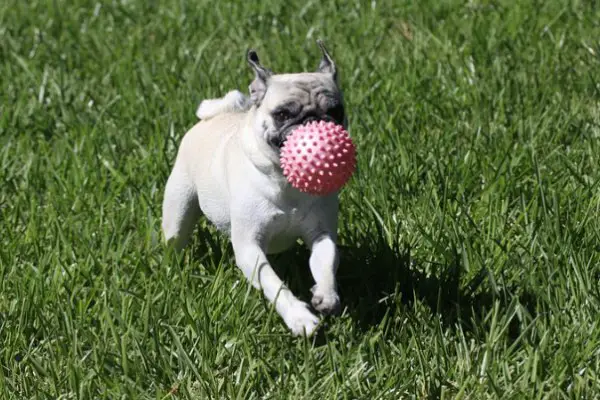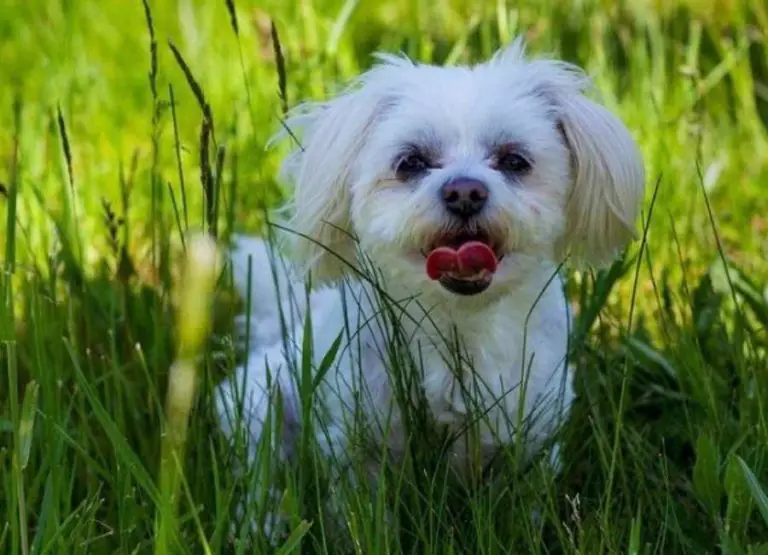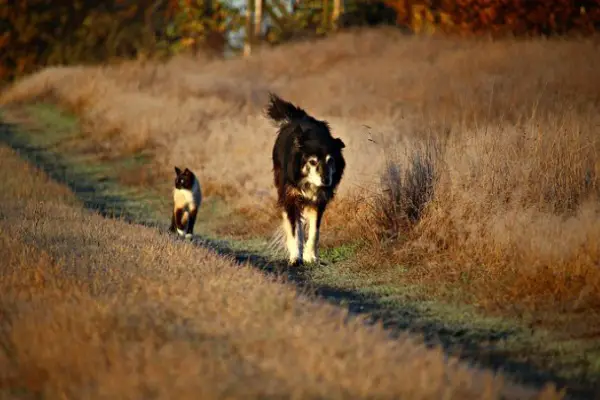9 Most Common Pug Behavior Problems & Fix

Begging is one of the most common pug behavior problems that owners should try to avoid as the can help your pug develop unnecessary behaviors.
In this post, we will outline and discuss all the most common pug behavior problems you should know before getting one.
Most of the common pug behavior problems you will see in this post were reported by some pug owners and can be resolved with the owner understanding them.
If you are ready… Let’s rock and roll with some common pug behavior problems.
Common Pug Behavior Problems
Pugs are a popular and endearing little dog breed, but they have several behavioral concerns, such as begging, housetraining troubles, jumping on humans, separation anxiety, excessive barking, destructive chewing, biting, and nipping.
Here are some of the most common pug behavior problems to be aware of, along with some helpful solutions:
1. Begging
The owner may find it difficult to resist the pug’s tempting expressions, which encourage begging.
Even though begging is a terrible habit, many pug owners encourage their dogs by feeding them while they eat.
Side effects include weight gain, gastrointestinal issues, and even recurrent diarrhea.
The most straightforward method to avoid this irritating habit is to never promote it in the first place.
How to stop pug from begging
- Don’t stare at your pug when he’s begging.
- Don’t talk to your pug when he’s begging.
- Twist and turn away if your pug tries to jump on you while begging.
- Teach your pug to do other things than begging for food at the table.
- Put your pug in his room or space while you eat.
- Place the bowl near the table when it’s time to eat, so your pug thinks he’s at the table with you.
- Use positive reinforcement to teach your pug that begging is associated with bad behavior.
- Ignore and redirect a begging pug.
2. Separation anxiety
Pug separation anxiety is a behavior problem that arises when a pug is left alone for an extended period of time without supervision.
If left untreated, it can lead to biting, excessive barking, and hostility.
Biting, nipping, barking, self-isolation, destructive chewing, and other behaviors are all signs of separation anxiety in pugs.
Separation anxiety can occur when a pug is left alone at home, which can be alleviated by having a companion or adopting good crate training.
How to fix separation anxiety in pugs
- Make an anti-anxiety product or pharmaceutical buy approved by your veterinarian.
- To keep the puppy engaged, make sure there are plenty of soft and interesting toys.
- Give yourself plenty of time to rest, relax, and engage in physical activity.
- Start your dog on a fresh, suitable crate training program.
- Make an appointment for your pet to see a behaviorist.
- Teach them to leave you alone at home and to maintain a safe space between you and them.
- Exercise your pug before leaving to burn off excessive energy.
- Provide a window view of the outside world.
- Provide a calming and stress-free spot with calming music.
3. Difficulties in house-training
Housetraining is the process of educating a dog to defecate outside or in a specific spot within the house, rather than following its natural instinct of pooping everywhere.
Housebreaking a pug is generally tough because of their dominating personality. Expect to practice for two to three months in sessions.
Your pug may make mistakes even after you’ve completed potty training. However, you may expect to see a nice puppy once you’ve completed it.
Housebreaking is one of the most typical issues with pug behavior. When you get a pug, try to focus on house training from the start.
Ways to fix house training issues in pugs
- Don’t overfeed your Pug during housetraining.
- When you’re not around, don’t keep your pug on a leash during the house-training procedure.
- Provide your pug with a variety of places to discharge himself during the house-training process.
- Take your Pug to the toilet periodically before bedtime throughout the housetraining process.
- You should start potty training your pug the day he comes at your place.
- If your pug commits a mistake, do not scream or strike him.
- Make no substantial modifications to your pug’s daily routine during the house-training process.
- Feed your pug at the same time and in the same manner throughout the housetraining procedure.
- During and after the housetraining procedure, make the toilet as accessible as feasible.
4. Unnecessary barking at inconvenient times
Since they were developed to be human companions, pugs are a naturally non-aggressive little dog breed that has never been known to harm other dogs or children.
Poor socialization, fear, anxiety, possessive behavior, and a lack of training or behavioral direction on the part of the owner can all contribute to aggression in pugs.
Pugs can bark excessively, and properly socializing your pug as soon as possible is one of the greatest ways to prevent excessive barking.
Tips
- Teach your pug a new behavior to get him to stop barking.
- Choose a location that can be seen from the front door.
- When you say, “Go to your place,” teach them to lie down and stay put.
- This will keep them active and quiet as they wait to be welcomed.
- Bring a treat and a buddy to the door, but only open it when your dog is calm.
- If you give them that treat frequently enough, they’ll learn to relax if they want it.
- Teach your pug how to stop barking excessively at any point.
- Learn ways to keep your pug occupied.
- Teach your pug to concentrate.
5. Play aggression
Nipping or biting when playing is one of the most well-known sorts of pug behavior disorders.
Growling, snarling, flashing fangs, lunging, and biting are all ways Pugs display their play aggressiveness.
It’s quite frequent among pugs since their owners always tolerate or promote it because it’s the correct thing to do.
Pug play aggressiveness develops over time and, if left unchecked, may lead to serious problems with both your children and your dog.
How to fix pug play aggression
- Begin by gently playing with your pug.
- Learn how to teach your Pug to control his or her excitement.
- Your pug’s socializing should begin at a young age.
- Make plans to play with other puppies as well as well-behaved adult dogs who can teach your puppy good manners.
- Your pug’s hormone-driven antagonism can be decreased by neutering or spaying him.
- When your pug engages in enjoyable play, praise him or her.
- Include a toy in the equation, and distract your pug when a line is passed to prevent him from continuing to play.
- Teach tactics and expectations for compliance.
- Positive reinforcement is the only way to progress.
6. Dominance issues
Pugs are infamous for being demanding and forgetting their size, which may be a severe problem if you have children in the house.
To avoid dominating behavior in your pug, it’s critical to properly socialize them.
Pug wants to take the lead while you follow, which may lead to a variety of behavior issues that, if not addressed, can result in unnecessary hostility.
How to fix dominance issues in Pugs
- Develop an “Alpha” mindset from the beginning.
- Establish yourself as the pack leader as early as possible.
- Set rules, limitations, and boundaries for your Pug as early as possible.
- Insist on proper conduct.
- Use positive energy when communicating.
- Find out how to act like an alpha dude.
- When it comes to disciplining inappropriate behavior, be consistent and fair.
- When it comes to regulations, be consistent and accurate.
- Teach your pug the concepts of obedience.
- Learn how to control and regulate how long your pug spends eating.
- Give your pug a job to perform at all times.
- It’s important to employ positive reinforcement.
- Behavior that is submissive should be praised.
7. Jumping on people
Pugs are notorious for leaping and jumping on their owners in an attempt to greet you and convey their joy at your return.
While leaping is entertaining, it is not always appropriate, and this may quickly become a significant problem.
Pugs are known for jumping up and down to greet their owners and anybody else that enters the house.
Teaching your pug to manage their enthusiasm is one of the basic tactics you may use to prevent them from leaping on you or another person.
How to stop your pug from jumping on people:
- When your pug is on a leash, have someone approach him.
- Before the individual approaches your pug, toss a few treats on the floor.
- Allow your pug to touch and greet you while he or she is eating from the floor.
- Before the person finishes eating, ask them to move away from your pug.
- Repeat the processes above after a few repetitions, but this time extend the welcome by putting treats on the floor throughout.
- Once all four feet are on the ground, let your pug to meet the person before placing the first reward on the ground.
- As your pug learns the rules, you may gradually reduce the amount of treats you give him until the greeting is the only thing he gets.
8. Chewing things when bored
Chewing is a normal pastime for all dogs, but if the dog chews on things that aren’t meant to be eaten, such as shoes, furniture, or electrical wires, chewing may quickly turn into a behavior problem.
Provide lots of toys and chews to keep your dog active and encourage appropriate chewing.
Objects you don’t want to be chewed can be removed or sprayed with a substance like Bitter Apple, which leaves a nasty taste in their mouth.
When bored or lonely, pugs chew to their hearts’ content.
How to control destructive chewing in pugs:
- Invest in lots of chewing toys.
- Spray your furniture.
- Provide more mental stimulation.
- Provide more exercise for your pug.
- Puppy proofing your home.
9. Clingy behavior
While some people find their pugs following them around the house looking for love irritating, others find it humorous.
Pugs are no exception when it comes to begging for attention by barking, biting, or nipping.
If you don’t want a loving dog who demands frequent care, a pug is not for you.
Pugs are lovely companion dogs that spend their days with their owners; yet, if they are not properly regulated, they may become a serious problem.
How to control pug clingy behavior:
- Time should be spent on obedience training.
- Teach the commands “sit” and “stay.”
- Make the time to properly crate train your pug.
- Provide a variety of fun and interactive toys.
- Provide tasks that stimulate the mind, such as puzzles.
- Give your pug a job to perform at all times.
- Establish a daily schedule and stick to it.
- Make sure you have a set of rules in place.
There you have the most common pug behavior problems and how to fix them.


![Dog Possessive Of Owner With Other Dogs [Causes & Fixes] Dog Possessive Of Owner With Other Dogs](https://petcreeks.com/wp-content/uploads/2023/02/Dog-Possessive-Of-Owner-With-Other-Dogs-768x555.jpg)

![Are Boston Terriers Aggressive [Useful Tips] Are Boston Terriers Aggressive](https://petcreeks.com/wp-content/uploads/2022/11/Are-Boston-Terriers-Aggressive-768x555.jpg)
![Training Tips For Dogs [13 Types of Dog Training] Training Tips For Dogs](https://petcreeks.com/wp-content/uploads/2023/09/dog-5020587_640.jpg)
